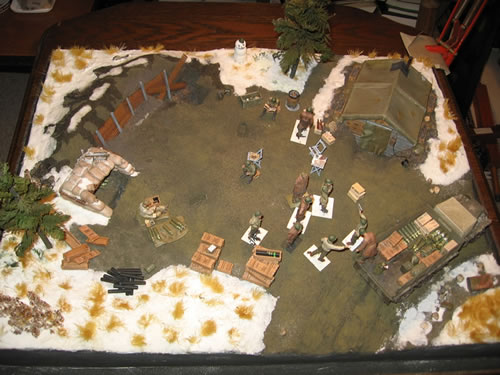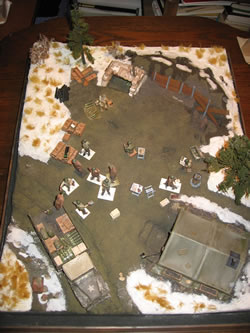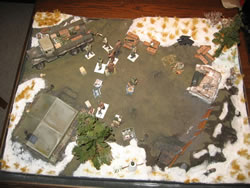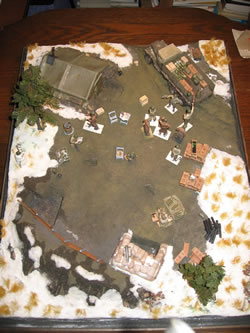Structure,
Base Coat, Relationships

Celluclay
was applied to the styrofoam base. When it was dry, I painted the
snow area white and applied a paint/sand mixture over the exposed
ground area. This ensured I had a good foundation for the Snow and
Dirt products from Hudson and Allen.
I
tried a different approach for creating the deeper snow than I had
used in a Stalingrad diorama. In that instance, I glued the H&A
Snow over a base of plaster. With this diorama, I spread a coating
of acrylic gloss medium and sprinkled the Snow over it. I also inserted
clumps of Scenic Woodlands grass, which stood up well in the gel-like
medium. However, the AGM sucked the snow down into it as it dried.
It gave an icy-snow look (very cold temps that have sucked the moisture
out of the snow) vs. the fluffier warmer-weather snow, which is
what I wanted (I live in Minnesota, so I've learned a few things
about snow...). So I had to go over the surface again with white
glue and Snow, which gave me what I wanted.
 Before
all of this, of course, the stryofoam base had been carved to accommodate
the dugout shelter the crew has devised, building a front wall with
discarded fencing and ammo box lids. The roof tarps were made of
two-part epoxy putty. This was also used to make the sandbags over
the ammo pit. Verlinden PSP sections were used to support the berm. Before
all of this, of course, the stryofoam base had been carved to accommodate
the dugout shelter the crew has devised, building a front wall with
discarded fencing and ammo box lids. The roof tarps were made of
two-part epoxy putty. This was also used to make the sandbags over
the ammo pit. Verlinden PSP sections were used to support the berm.
The
field was further accented with fibers from an old doormat and bits
of garden scraps for the field foliage. H&A Pine Boughs were
inserted into whittled twigs to make up the pine trees.
Before
the figures were fixed in place, I gave the bare dirt areas a final
coating of H&A Dirt mixed with sand, water, and a dollop of
white glue. This went over the base color quite well and I had no
nasty white patches of Celluclay to have to touch up.
I
wanted to convey that sense of weather in a freeze/thaw/freeze pattern,
and not do another wet, muddy road. I used H&A Slush to give
an icier look along the sides of the road and the perimeter of the
snow, and used my palatte knife to press it into the dirt ground
in random areas where the soldiers would have packed the snow down.
I then went over the Slush with a wet brush of water dirtied with
a mix of dry pigments to take off the gloss and give it the look
of trodden snow and ice. The results are evident on the Final
Touches page.
When
I conceived this diorama, I wanted to establish a sense of activity
and purpose, which is suggested by the mounds of boxes (Custom Dioramics
and Verlinden) black fiberboard tubes (Tiger Model Designs), and
metal tubes (AFV Club), along with ammo rounds (again AFV Club).
The AFV Club comes with post-war markings, so I had to create my
own. With the help of Kurt Laughlin's bottomless resources and Mike
Canaday's graphics expertise, I had decals for both HE and smoke
shells, as well as the two types of tubes (each type having two
sizes). I didn't make a final count, but there are probably 100
tubes and 40 rounds of ammo. Plus several dozen boxes, each requiring
eight separate decals. I spent a lot of time putting decals on small
pieces!
 The
added details continued with discarded grommets and fuze tubes.
Rations cans and boxes can be seen here and there. The
added details continued with discarded grommets and fuze tubes.
Rations cans and boxes can be seen here and there.
The
chest and some of the tools from the erstwhile Kendall Model Company/
Trakx 105mm gun maintenance set was employed since many of the tools
were identical to those for the 155mm howtizer.
I
continued to experiment with the layout until the end, repositioning
figures and gear. I kept looking at the arrangement from all sides.
I enjoy the art of composition, of creating and breaking patterns.
And have some grounding in historical accuracy.
 I
also like the challenge of setting up relationships between the
characters. Who are the men grouped together? Who are the men who
are set apart? I
also like the challenge of setting up relationships between the
characters. Who are the men grouped together? Who are the men who
are set apart?
I'm
not so much into what is referred to as "telling a story"
as much as I am in establishing logical and realistic action within
a particular event. In this scene, the mail man comes calling as
the crew is getting ready for business. Not much of a story there.
But if the action of this event is clearly conveyed and the viewer
takes an intellectual or emotional interest in it, then I have accomplished
what I've set out to do.
Building
Italeri's 155mm Howitzer
Background on the
155mm Howitzer
Overview
of the Model and References
Building the Howitzer Assembly
Building the
Carriage Assembly
Painting and
Accessories
Pictures
from the Technical Manual
155mm Ammunition
Pictures
of Museum 155mm Howitzer
|












